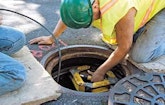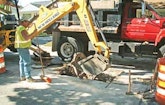Interested in Manholes?
Get Manholes articles, news and videos right in your inbox! Sign up now.
Manholes + Get AlertsIn 2004, multiple storms in Milwaukee caused a series of overflows that sent untreated sewage into waterways that empty into Lake Michigan. While the area sewerage district’s “deep tunnel” inline storage system helped keep the number of overflows down, it was impossible to eliminate them.
Inflow and infiltration of stormwater runoff into the sanitary sewer was a big contributor to the problem. In response, the 28 communities that comprise the Milwaukee Metropolitan Sewerage District (MMSD) are looking at ways to curtail I&I.
For the district’s biggest member, the City of Milwaukee, manholes have been a big area of focus. As part of a legal settlement reached in 2005 between the Wisconsin Department of Justice and the 28 MMSD municipalities, Milwaukee has launched a citywide program to inspect and repair its 22,824 manholes.
Inspecting about 20 percent of its inventory every year for the past five, the city has looked closely at all those manholes. This year the city will make repairs on the final 20 percent of manholes, while also beginning a new five-year-round of inspections.
It’s a project that brings a certain satisfaction, says Timothy Thur, chief sewer design manager for the city. A solid manhole inspection and repair program “is a good cost-benefit project,” he says. “It’s clear up front that we can do the work — it’s in the public right-of-way, it’s relatively straightforward, and you can remove a lot of I&I by doing that. It’s low-hanging fruit.”
Facing the elements
Manhole rehabilitation has long been a part of the city’s public works agenda, encouraged by sewerage district mandates to reduce stormwater in the sanitary sewer system. Programs have gone as far back as the 1970s and 1980s. In those years, dye and smoke testing found manhole chimney defects that required repairs.
As a snowbelt city, Milwaukee endures annual freezing and thawing, and so do its manholes. The expansion and contraction of bricks and concrete can crack the manhole chimneys and shift the positions of the iron manhole frames.
“This section of the manhole is usually constructed with brick or concrete rings that are a couple of inches thick and have mortar joints between the layers,” says Kurt Sprangers, a city engineer who works on the manhole inspection and repair program. “Therefore you have several joints between the brick or rings located in the freeze/thaw zone that could potentially deteriorate and become an opportunity for clear water to enter the sanitary system.”
Because of that, starting about two decades ago, the city began requiring the installation of internal chimney seals on manholes. “We’ve been installing chimney seals on any new manhole installations or when replacing existing sewers,” says Thur.
The seals consist of rubber sleeves held in place by stainless steel expansion bands and cover the seam or seams between the manhole frame and the masonry rings and manhole chimney.
Installation and replacement can be completed in just a few minutes. After releasing the expansion bands on an old seal and using a tool such as a crowbar to pry off the rubber, workers then apply quick-set patching mortar if needed to smooth out the interior of the chimney where the seal will go. The new rubber seal is positioned against the manhole frame and the chimney area and then held in place with the two or more expansion bands, which can be tightened with a hydraulic or manually operated tool.
“We prefer internal seals so that they can be inspected, and removed or replaced as needed,” Sprangers says. Replacing external seals requires excavation around the manhole chimney.
The city’s principal chimney seal suppliers are Cretex Specialty Products, based in nearby Waukesha, and NPC Inc., now Trelleborg Pipe Seals Milford, in Milford, N.H.
Legal resolution
The current round of inspection and repairs grew out of a court settlement with the state after the 2004 overflows. The litigation arose from alleged violations of permits issued by the state Department of Natural Resources. The 2005 settlement of that suit between the state and the 28 communities in MMSD required a manhole inspection program, followed by repairs within 18 months of the inspection.
The lawsuit and the resulting inspection program apply only to the city’s separate sanitary sewer system, not to the combined sewers that serve about 36 percent of the city’s wastewater collection needs, primarily in older parts of the city.
With nearly 23,000 manholes, “There was no way to do it in one year, especially from a budget standpoint,” Thur says. Instead the staff divided the city into five sectors from north to south and inspected 4,000 to 5,000 manholes a year starting in 2006. The year after inspection in each sector, crews followed up with rehabilitation as needed.
Milwaukee contracts with private firms to inspect and repair manholes. For the inspection, two-member crews go out with system maps to each assigned manhole. “They take a couple of pictures of the manhole from the surface with the lid closed, so you can see pavement cracks around it,” Sprangers says. “Then they take pictures of the interior of the manhole from the surface — from street grade.”
As the contractors inspect the site, they enter data into laptop computers loaded with the city’s own database. “They fill out about 40 pieces of information about each manhole,” Sprangers says. Questions cover everything from the condition of the manhole lid and frames to the need, if any, for substantial repairs.
“They inspect the condition of the existing seal, if there is one, or notify us if there is no seal,” Sprangers says. Inspectors look for damaged brickwork and concrete in manhole chimneys and for other I&I indicators, such as calcium buildup or water stains.
The inspection proceeds down the barrel of the manhole to the flow line and the bench. Inspectors record measurements including the depth of the manhole and the chimney diameter.
Up to now, the city has not included pole camera or other specialty sewer camera work in its manhole inspections — only standard digital cameras. Those became the standard in the 1990s as the city made its manhole inspection process more detailed and standardized. The pictures have helped ensure accuracy in the inspection reports.
Three out of four
In the past three years, roughly three of every four manholes inspected have required at least some repairs. “A lot of times it’s very minor — just replacing a manhole cover with a cover that has a solid lid — no venting holes of any kind,” Sprangers says. Solid covers, instead of those with vents for sewer gas, have become the city’s standard.
“In our system there’s enough movement of the water, there’s enough pitch in the sewers, that we don’t see a buildup of sewer gases,” Sprangers says. Besides solid covers, the MMSD requires the city to put rubber gaskets under each manhole lid.
Some repairs demand a lot more than a new lid — perhaps new chimney seals or even partial or complete rebuilding of the chimney. Thur says the most reassuring finding from the inspection program has been how few manholes had to be completely replaced. “Every year we might have done 10 to 15 replacements for the whole manhole,” he says.
More troubling, though, was the number of manholes for which the tops had become misaligned with the rest of the barrel by as much as six inches to a foot, often from repaving mishaps. Inspections found as many as 100 to 150 such cases per year.
“A lot of manholes did require digging up and fixing that top foot of chimney and frame,” Thur says. “That surprised me. The whole frame shifts over so it creates gaps where water can get in.” The shifts also make it more difficult for workers to enter manholes. Frost heave, meanwhile, creates mostly vertical dislocation.
Making it better
As work has progressed, technology has changed. For instance, chimney seals were once just 6 to 8 inches deep and had to be stacked one atop another to stop leaks that went deeper down the manhole barrel. Today, seals are available in a wide range of sizes, to as deep as 24 inches if needed.
The city has also changed how it writes its repair contracts. “We learned early on that we had to limit how many manholes could be worked on at any one given time,” says Thur.
The city also sets strict time limits for completion. “We had neighborhoods where they had 100 manholes open and streets cut up around the manholes,” says Thur. “They were sitting for too long a time, and residents were getting very frustrated.”
Now, contractors are required to do the jobs in smaller batches, perhaps 20 at a time, and to complete them faster. The city also has tightened specifications for how much pavement contractors should remove around a manhole. “We sit down with the city construction inspectors annually and discuss what’s working and not working on our contracts,” says Thur. “Then we try to modify it to make the work go smoothly, have less impact on the residents, and make it easier for the work to get done in a timely manner.”
City staffers continually evaluate the program and tweak it as necessary based on consultations with inspection and rehabilitation contractors, and on feedback from the city’s own inspectors. “Each year it’s gotten to be an easier project, because of that continuing evaluation and improvement,” Thur says.
Thur’s office, the environmental engineering section, also stays in regular touch with the transportation group in charge of street repairs to coordinate manhole and other sewer repairs with street work as much as possible.
A job worth doing
The inspection program started out at an annual cost of nearly $200,000, but that has dropped to about $125,000 a year. For repair contracts, the city has budgeted $2.5 million a year for each of the past four years. Thur thinks that figure will drop when the city returns to re-inspect areas already inspected and repaired previously.
The biggest challenge is probably the sheer size of the program. That translates to a huge volume of data for each manhole. “Trying to keep track of all that gets a little challenging,” Thur says. But the project has its rewards.
“You’d come across sites where you could see a sanitary manhole in a depression with a hole in the lid or something like that,” says Sprangers. “That was a situation where you knew water was getting in, and now you’re out there actively resolving that issue. It was something that was visibly fixable.”
While Milwaukee’s manhole inspection program was imposed by the court, Thur is “absolutely” glad to have undertaken it. While he can’t yet point to hard numbers to quantify the benefits, he knows they exist. “The city has experienced a number of large storms the last few years,” he says. “We’re seeing an awful lot of homes that get backwater as a result of it.
“When it’s happening to a homeowner two or three years in a row, it’s very frustrating, for them and for us. This is something that we can do. It’s not going to solve all the problems, but it certainly eliminates some sources of the problem.”
Manhole inspection and repair also has benefits beyond I&I reduction. “It helps the street itself,” Thur says. “It helps prevent potential liabilities, such as when a cover sinks in, cars drive over it, and the city gets claims for car damage. It just made good sense to do it.”












